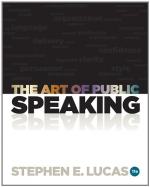For those who make notes and with their aid write out the speech, these suggestions may prove helpful:
After having read and thought enough, classify your notes by setting down the big, central thoughts of your material on separate cards or slips of paper. These will stand in the same relation to your subject as chapters do to a book.
Then arrange these main ideas or heads in such an order that they will lead effectively to the result you have in mind, so that the speech may rise in argument, in interest, in power, by piling one fact or appeal upon another until the climax—the highest point of influence on your audience—has been reached.
Next group all your ideas, facts, anecdotes, and illustrations under the foregoing main heads, each where it naturally belongs.
You now have a skeleton or outline of your address that in its polished form might serve either as the brief, or manuscript notes, for the speech or as the guide-outline which you will expand into the written address, if written it is to be.
Imagine each of the main ideas in the brief on page 213 as being separate; then picture your mind as sorting them out and placing them in order; finally, conceive of how you would fill in the facts and examples under each head, giving special prominence to those you wish to emphasize and subduing those of less moment. In the end, you have the outline complete. The simplest form of outline—not very suitable for use on the platform, however—is the following:
WHY PROSPERITY IS COMING
What prosperity means.—The real tests of prosperity.—Its basis in the soil.—American agricultural progress.—New interest in farming.—Enormous value of our agricultural products.—Reciprocal effect on trade.—Foreign countries affected.—Effects of our new internal economy—the regulation of banking and “big business”—on prosperity.—Effects of our revised attitude toward foreign markets, including our merchant marine.—Summary.
Obviously, this very simple outline is capable of considerable expansion under each head by the addition of facts, arguments, inferences and examples.
Here is an outline arranged with more regard for argument:
FOREIGN IMMIGRATION SHOULD BE RESTRICTED[11]
I. FACT AS CAUSE: Many
immigrants are practically paupers.
(Proofs involving statistics
or statements of authorities.)
II. FACT AS EFFECT:
They sooner or later fill our alms-houses
and become public charges.
(Proofs involving statistics or
statements of authorities.)
III. FACT AS CAUSE:
Some of them are criminals. (Examples of
recent cases.)
IV. FACT AS EFFECT:
They reenforce the criminal classes.
(Effects on our civic life.)
V. FACT AS CAUSE: Many
of them know nothing of the duties of
free citizenship. (Examples.)




